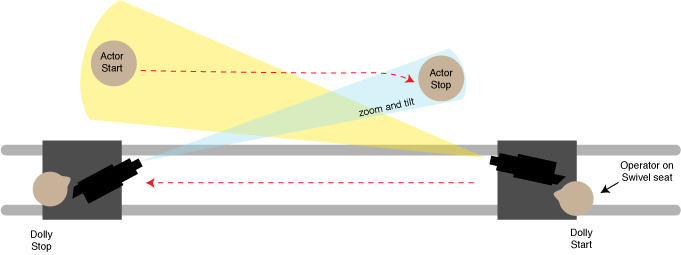Pivoting Seat vs. Stationary Seat vs. No Seat
PIVOTING SEAT
We think that one of the best features of our 4-Leg Spider is the combination of our Pivoting Seat mounted on the Swivel Seat Mechanism. The Swivel Seat Mechanism pivots 360 degrees around the column, while the Pivoting Seat allows the camera operator to move in and out relative to the column. Putting these two motions together gives the camera operator the ability to leave his eye tucked into the camera’s eyepiece as his body moves effortlessly in concert with the panning motion of the fluid head. This in turn gives him the opportunity to concentrate on his framing and, if needed, incorporate a zoom or focus pull with his left hand as his right hand pans and tilts the fluid head.Let’s consider the following shot requirement: As the dolly is tracking to the left, our actor is walking in the opposite direction passing by the dolly as it continues to track. The actor stops and turns to look over his right shoulder towards the camera, which tilts up and zooms in on his face as the dolly comes to a quick stop.

As we said, with our Pivoting Seat on the Swivel Seat Mechanism, the camera operator will be able to keep his eye to the eyepiece easily following this action as the camera pans about 150 degrees during the shot.
STATIONARY SEAT
Now consider this shot if on a stationary seat like those found on some three wheel dolly systems.
The seat does not pivot and is positioned over a wheel to prevent tipping. Obviously one could start the shot the same way, but as the camera pans to the right, the eye has will have to come away from the eyepiece, so a monitor will be needed for viewing, but it cannot be a flip screen, because you will not be able to see it as the camera pans to the right. If an on-board monitor is added to the top, you will be able to see a bit better, but only if you can counter-pan it during the shot. However, the biggest problem is that the pan bar coming from your right and moving left to accommodate the 150 degree pan will cause you to lean completely out of the seat. In other words, you cannot really do this shot with this dolly configuration.
So please remember, all seats are not alike, and complex moves are difficult if not impossible to make while walking a dolly.
NO SEAT
One cannot effectively stand on a 3-leg system because the dolly will tip if one's weight is not directly over a wheel. Therefore one must walk next to the dolly as it tracks. The main problem with the walking 3-Leg system (ours included) is that camera moves cannot be too complex. In the above example, one could do the tracking of the dolly, and the panning of the camera, but controlling a zoom and focus pull would be quite difficult. When walking a 3-Leg system, since the camera is generally pointing somewhat perpendicular to the track, the operator has to walk sideways in a rather clumsy step-over-step fashion. And since he is outside of the track, it is difficult for him to reach the zoom and focus controls of the lens, although this could be helped by adding a remote zoom and focus controller to the panbar. Next let's consider standing on a larger dolly, like a traditional doorway dolly without a pivoting seat. Now you have plenty of room to move around the tripod mounted on the dolly, so there is no tipping issue or leaning out of the seat issue. With this system one should be able to do the shot described above, but with two disadvantages. 1) You must use a much larger dolly, so you lose the portability of a smaller dolly, and 2) coming into a quick stop feels very different when one is standing rather than seated. A quick stop while standing will cause your upper body to lurch considerably, whereas when seated you do not experience this. We have had many owners of traditional doorway dollies buy our Adjustable column and Seat Assembly to add to their dolly to make them more effective than working with a tripod on the dolly.So please remember, all seats are not alike, and complex moves are difficult if not impossible to make while walking a dolly.


